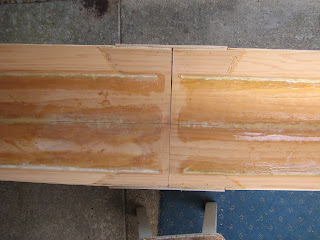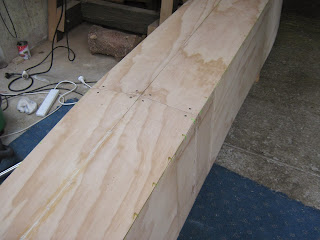Alignment
To get the two half-boats to align and bolt together, I drilled four 6mm holes through both central bulkheads for some stainless steel bolts from the Channel Tunnel. - This is actually true. There was this bloke in Quorn mysteriously selling a large number of stainless steel bolts commissioned for the building of the Channel Tunnel, and I got a tin of them off him thinking that one day long in the future I would need them for something, and so it has now proved. My, I'm blessed with foresight.
Having glued up both keel seams I was shocked and stunned to find that, when the thing was turned upside down, the two garboard strakes had become an aircraft carrier launch ramp. - No I wasn't, silly, I was anticipating that mishaps would occur as work progressed. - What had happened was that, being pretty supreme in the unintelligent department, I had imagined that the centre bulkheads would be adequate to align the bottom planks and that I wouldn't need to sew the latter together; and when I temporarily screwed in the bulkheads and glued the keel, a gap appeared and got glassed over. Hence the flare of the planks, which I would have photographed but didn't because
a) it was hard to see except in real life and
b) I forgot.
So I sawed mournfully down my new seam, and wondered how to prevent what would have been a horrid hydrodynamic cross-ridge right in the middle of the boat.
Eventually it occurred to me that I could screw some long planks on the bottom and use them to fix the two half-boats together, and the long planks would force things into line. And d'you know, this actually worked.
First some trimming of the sideplank ends had to take place to make the middle of the assembled keel the lowest point, and this meant cutting a triangle off the back of the sideplanks, the triangle being 15 mm wide at the top and 0 mm wide at the bottom. So I did that, and screwed the additional planks to the bottom of one boat-end, and very carefully sighted down the line of the two 'keels' to get them dead straight, and screwed them to the second boat-end, and then screwed a couple of short additional planks to the sides to hold them in right line.
Then I turned the whole boat over.
One side had a gap twixt front half and back half: the other was flush.
I measured the gap and it was a most convenient 4mm, so I made a third central bulkhead of 4mm ply to keep the two actual central bulkheads parallel, and in an amazingly difficult bit of larding glue all over the place incl. shirt trousers left arm and hair, managed to glue the two central bulkheads in place, using a sash cramp at the bottom until I was able to put in some temporary screws. This took more-or-less forever. Afterwards I discovered that Iain Oughtred is correct: you can clean epoxy off your skin with white vinegar and it's probably not as bad for you as cleaning it off with acetone.
When the glue was reasonably hard I undid the four Channel Tunnel bolts and split the boat at the glueline, which wasn't all that easy because a lot of glue had seeped out and made contact between the two ends. The glue was brittle, which tells me to be wary of much flexing.
Then to prising off the intermediate 4mm bulkhead spacer, and angle-grinding most of the surplus wood and glue off.
Your proper boatbuilder will squeal with anguish at the angle-grinder confession but I am indifferent. Nobody will ever know because I finished the job with a cabinet scraper, and if you haven't ever used one, seven minutes of your remaining lifespan will show how and lend satisfaction to your every future bit of woodworking.
When all was done I bolted the ends back together and was relieved to find the boat dead straight from end to end.
And then it started raining and hasn't stopped, so no more gluing has taken place because I don't want to glue slightly damp surfaces together.
Having glued up both keel seams I was shocked and stunned to find that, when the thing was turned upside down, the two garboard strakes had become an aircraft carrier launch ramp. - No I wasn't, silly, I was anticipating that mishaps would occur as work progressed. - What had happened was that, being pretty supreme in the unintelligent department, I had imagined that the centre bulkheads would be adequate to align the bottom planks and that I wouldn't need to sew the latter together; and when I temporarily screwed in the bulkheads and glued the keel, a gap appeared and got glassed over. Hence the flare of the planks, which I would have photographed but didn't because
a) it was hard to see except in real life and
b) I forgot.
So I sawed mournfully down my new seam, and wondered how to prevent what would have been a horrid hydrodynamic cross-ridge right in the middle of the boat.
Eventually it occurred to me that I could screw some long planks on the bottom and use them to fix the two half-boats together, and the long planks would force things into line. And d'you know, this actually worked.
First some trimming of the sideplank ends had to take place to make the middle of the assembled keel the lowest point, and this meant cutting a triangle off the back of the sideplanks, the triangle being 15 mm wide at the top and 0 mm wide at the bottom. So I did that, and screwed the additional planks to the bottom of one boat-end, and very carefully sighted down the line of the two 'keels' to get them dead straight, and screwed them to the second boat-end, and then screwed a couple of short additional planks to the sides to hold them in right line.
Then I turned the whole boat over.
One side had a gap twixt front half and back half: the other was flush.
I measured the gap and it was a most convenient 4mm, so I made a third central bulkhead of 4mm ply to keep the two actual central bulkheads parallel, and in an amazingly difficult bit of larding glue all over the place incl. shirt trousers left arm and hair, managed to glue the two central bulkheads in place, using a sash cramp at the bottom until I was able to put in some temporary screws. This took more-or-less forever. Afterwards I discovered that Iain Oughtred is correct: you can clean epoxy off your skin with white vinegar and it's probably not as bad for you as cleaning it off with acetone.
When the glue was reasonably hard I undid the four Channel Tunnel bolts and split the boat at the glueline, which wasn't all that easy because a lot of glue had seeped out and made contact between the two ends. The glue was brittle, which tells me to be wary of much flexing.
Then to prising off the intermediate 4mm bulkhead spacer, and angle-grinding most of the surplus wood and glue off.
Your proper boatbuilder will squeal with anguish at the angle-grinder confession but I am indifferent. Nobody will ever know because I finished the job with a cabinet scraper, and if you haven't ever used one, seven minutes of your remaining lifespan will show how and lend satisfaction to your every future bit of woodworking.
When all was done I bolted the ends back together and was relieved to find the boat dead straight from end to end.
And then it started raining and hasn't stopped, so no more gluing has taken place because I don't want to glue slightly damp surfaces together.
Labels: Aligning a nesting dinghy, cabinet scraper, Channel Tunnel bolts, woodwork with angle grinder










0 Comments:
Post a Comment
Subscribe to Post Comments [Atom]
<< Home